#and how the narrative offers him to embody romance-as-theme
Text
i will simply by virtue of who i am read aromanticism into things, but mash really does make it astonishingly easy for me
#MASH#if we're looking at the romantic relationships id say klinger and soon-lee#have most everyone else beat#if not everyone -- klinger himself is also just (imo) the most romantic character both in terms of how he views romance#and how the narrative offers him to embody romance-as-theme#potter and mildred is very sweet and has that *we've been together for so long we simply know the beats of one another* thing#but is also a relationship in which one of the parties spent several years going to different wars and practising army medicine#(this is subjective but the *I cheated on mildred confession* -- I choose to ignore it... I simply don't think it works/does anything)#(and without that there's already so much to unpack in their relationship to one another)#next in line id say bj and peg and that is... interesting........ he cheats on her once and considers leaving her another time#this could be read many ways but i choose to believe that those situations wouldnt have happened if he hadn't been drafted#but they did happen + the jealousy plots + some of the overbearing ways he treated hawkeye#(again last of those can choose to relate or not to relate to his marriage i choose to relate them) + general lashing out#but i do currently fall in the place of reading that relationship as coming out of love and them trying their best#then we've got henry and trapper who I think like their wives (but to varying degrees also bad-mouth them + cheat on them)#and will also say there that apart from the one scene with flagg there don't seem to be indications that they cheated outside the war either#(i say this -- i could be misremembering -- it seemed like the three-night-stand with trapper lady was before his marriage?)#(anyway we're newish fans here there could be things ive forgotten)#then we've got frank burns and... *i happen to believe in the sanctity of marriage no matter how ugly or disgusting it gets*#(paraphrased but you get the picture)#now for the ones who don't end the narrative with romantic partners: mulcahy charles hawkeye margaret radar#mulcahy is never given a *what if romance were to make you doubt yourself as a priest* narrative and am pretty glad of that#his tension gets to be more complicated without that imo#charles has a couple of romance-ish arcs that are snuffed out (the un-wedding is... very interesting very aromantic vibes)#+ him and his Responsibilities which is about the most unromantic way of looking at it as you can get (also strong ace vibes)#radar is slightly trickier in that he's in that odd space of being considered adolescent but then also not and loses his virginity 100 times#he seems to want a partner but although the conversation with the nurse in his last outing is sweet he's noticeably on that front#not fully *allowed* to just... grow up -- recognises that as a problematic phrasing on purpose because i feel like with radar#sex and romance is often tied to the idea of adulthood... i like seeing him as aroace and the space is there for it for sure!#(redefining adulthood for himself?)
19 notes
·
View notes
Note
I sent you the last question. and although I'm not going to argue, there are some points I should clarify.
«that you ship kat.aang.»
You're wrong, I don't ship kataang. I agree that this is a good ending to the show if the creators wanted a romantic ending, because kataang is a story, supported by multiple references and symbolism, about two children, two survivors of the genocide who fought for victory shoulder to shoulder and now go forward together as partners to build a new and better world. this is a very beautiful ending, embodying all the main themes of the show. But I am not an active shiper and would quite agree to an ending in which kataang would not be canonically confirmed.
«what a pity that they didn't end the show with a beautiful, strong, intimate friendship that provided the perfect foundation for a romance to develop.»
Yes, just like the show ended with Zuko's beautiful, strong, intimate friendship with Sokka, Toph and Aang. Zuko and Katara ended the show as friends, but there was never anything in their relationship that Zuko didn't have with Sokka, Toph, or Aang. With Aang, in fact, Zuko has much more parallels, symbolism and friendly interaction (apparently, on this basis it should be assumed that zukaang was robbed).
«it is usually good to provide this little thing called evidence when carrying out analysis.»
it would be my plesure:
"Your sister. She hates me! And I don't know why, but I do care what she thinks of me."
"Now that I know he's out there ... now that I know we can find him, I feel like I have no choice."
These are quotes from the show. it would be great if you revisit the show itself from time to time, if you undertake to talk about how poorly the writers understand the characters.
«their choices are made for them by writers whose job is to make those choices make sense within the scope of their own narrative arcs, and fit the themes and messages of the show.»
which is what we are talking about. Kataang developed literally from the first episode, we saw how Katara's feelings for Aang were born and developed.
s1 ep 14 Katara first starts thinking about Aang as a potential partner.
s2 ep 2 Katara first offers to kiss Aang, is offended when he refuses and then blushes when she later remembers the kiss.
S3 ep2 Katara is jealous and offended when she sees other girls flirting with Aang, and then rejoices when he invites her to dance and looks at him with loving eyes during the dance.
S3 ep10 Katara blushes when Aang kisses her and anxiously watches as he flies away to fight the firelord.
S3 ep17 The whole episode very clearly mocks the idea of zutara. We see how the propaganda of the fire nation mock Katara rasistic way as a brown girl, overly sexualizing her, showing zutara in his performance and forcing «katara» to say that Aang is like a brother to her.
S3 ep21 Katara initiates her and Aang's kiss. It is important that kataang happens on her terms and it is she who initiates the beginning of their relationship.
You'll just have to throw these pieces out of the show and ignore the feelings and aspects of Katara's personality to claim that it didn't happen. when I say that kataang and maiko are canon, i dont mean at all "bryke and ehaz wanted to make them canonical and did." I mean, "it logically follows from the characters, from the symbolism and themes of the show." The development of the characters is important, not what the writers wanted.
I'm not going to continue this conversation, it would just be cool if you didn't literally throw whole pieces out of the show and ignore the character of Katara to prove that your ship is something more than just a fanon.
sweetie, there is not a thing you’ve shown me in any of our discussions (and i use that term generously, given that all you’ve done is refuse to engage with my arguments, continue spewing the most egregious misinterpretations, and generally be walking proof of what happens when you don’t pay attention in english class) so far that could convince me that you’re worth giving any more of my attention to.
if you are actually interested, i have addressed all of your “points” and more here — but of course, you never came to me looking for a good-faith, intellectual debate in the first place, given that you didn’t even have the guts to stand by your own arguments without hiding behind anon.
i hope someday you’re able to find joy in something other than bothering strangers on the internet just because they like two different fictional people kissing than you do.
have a good day 🥰
#zutara#anti kataang#any further messages in my inbox will be deleted without being read 💗#just letting you know since you seem somewhat concerningly obsessed with me
46 notes
·
View notes
Text
Inuyasha and Kikyo Is the Feudal Romance We Deserved
Inuyasha and Kikyo are well known for their doomed romance in Rumiko Takahashi's iconic Inuyasha series. But what if Kikyo had lived instead?
BY DIANE DARCY
PUBLISHED MAY 16, 2021
With the 2020 debut of Yashahime: Princess Half-Demon, fans of the original Inuyasha series got an opportunity to revisit familiar faces as well as meet the children of their favorite pairings who front the new series. But what if one of these pairings had turned out differently? What if, instead of dying and reincarnating as Kagome Higurashi, Kikyo had actually lived to spend the rest of her life with Inuyasha?
While Kikyo living would’ve resulted in a very different story from the one Inuyasha creator Rumiko Takahashi developed, it also could’ve resulted in a more epic romance story. What is it about Inuyasha and Kikyo as a couple from 50 years ago that makes them so compelling? The characters could have developed very differently, with some fascinating aspects of Japanese history enriching their story even further.
In both the manga and anime, one of the unifying themes of Inuyasha and Kikyo's relationship is the two characters feeling out of touch with their humanity. In Inuyasha's case, he is a hanyou (a being who is half human and half youkai) born to a human mother and a great dog youkai, both of whom had high status in their respective communities. Despite this, however, Inuyasha was rejected by both humans and youkai alike for not being of pure blood. As such, he was forced to fend for himself at a very young age, resulting in feelings of self-loathing and a profound distrust in others.
Kikyo was born into a human village that she later protected as a miko (shrine maiden) after reaching adolescence. Little is known about her childhood apart from the fact she was born with strong spiritual potential (as narrated by her younger sister Kaede), though much of it can also be pieced together based on the history of miko in Japan. As stated by Tsubaki -- a rival of Kikyo -- in Episode 147 of the Inuyasha anime, a miko's spiritual power thrives when she abandons all human feelings. She also warns that as a woman, Kikyo could naturally fall in love, which would cause her powers to weaken.
Though Tsubaki's explanation of a miko's spiritual power is treated as a curse by Kikyo in the anime, it is actually consistent with how young girls trained to become miko in Japan's earlier history, most notably during the Sengoku period (when Inuyasha takes place) and especially in centuries prior. As practitioners of Shinto, young girls who trained to become miko underwent various purification rituals as a way of strengthening their spiritual power. Since purity is central to the Shinto belief system, miko were not permitted to marry as it was believed that compromising their sexual purity would also compromise the strength of their spiritual power. This last part is relevant to Kikyo's storyline.
Inuyasha and Kikyo's storylines converged when the latter was given custody of the Shikon no Tama, a powerful jewel with a reputation to grant any wish to its possessor. Inuyasha desired the jewel as a means of erasing his humanity in exchange for becoming a full youkai, though he had to get through Kikyo to get it. While Kikyo had the skills and power to keep the jewel safe, she also found her new occupation even more isolating than being a miko alone. After meeting Inuyasha, Kikyo became aware of her human desires and emotions, which factored into her decision to rid herself of the jewel and pursue life as an ordinary woman.
The premise of Inuyasha desiring to erase his humanity with Kikyo desiring to reclaim her humanity created strong story potential that deserved further fleshing out. This was done to an extent in the anime story The Tragic Love Song of Destiny (Episodes 147-148) that depicts the budding romance between Inuyasha and Kikyo, leading up to the moment where she proposed Inuyasha use the Shikon no Tama to become human. At the time, Kikyo theorized that if the jewel was used to make Inuyasha fully human, it would be purified and would cease to exist. The original Inuyasha manga and subsequent anime adaptation, of course, established towards the finale that this would not have been the right wish. But realizing this could've been an important part of Kikyo's journey.
Another major development that could've still happened in a universe where Kikyo lived is the shattering of the Shikon no Tama -- this time by a weakened Kikyo, which would've been a huge wakeup call for her. Recalling what Tsubaki said earlier about how falling in love would cause her powers to weaken, being responsible for shattering the very jewel she was entrusted to purify would've shaken Kikyo to the point of rethinking her priorities. This would've placed Kikyo in a position of needing to learn new skills to supplement her miko training, which in turn could've created opportunities for character growth.
A meaningful change that could've come out of this journey was Kikyo realizing that the key to strengthening her spiritual power was embracing all aspects of her identity. Maybe she needed to realize that rejecting any part of herself -- whether it be her human self or miko self -- was why she wasn't being an effective guardian of the jewel. Allowing herself to experience human emotion may have allowed her to channel her powers in a smarter, more effective way.
Related to the plot of shattering the Shikon no Tama, the wounded thief Onigumo (whom Kikyo was nursing in a cave) could've still become the evil hanyou Naraku with the same motivation as before: wanting Kikyo for himself and desiring the Shikon no Tama as a means of getting her love. He still could've sent various youkai after Kikyo to exhaust her as he did in Tragic Love Song, only things didn't go his way. Instead of mortally wounding Kikyo, one of these attempts to exhaust her could've resulted in the aforementioned jewel's shattering, allowing the story to play out as it did originally -- but with some key differences.
Keeping Naraku as a villain would've still been important for Inuyasha's character development as he embodied a much darker version of Inuyasha's own goals. This could've forced Inuyasha to reconsider his own motivations for becoming a full youkai and whether or not he should take up Kikyo's offer to become fully human. Naraku's obsession with Kikyo could've similarly made Inuyasha re-evaluate his own feelings for Kikyo, whether he's similar to Naraku in lusting for her or if he actually loves her as a person. There's also the factor of Kikyo being exposed to Inuyasha's human side during moonless nights and the vulnerabilities that come with such moments. This too could've forced her to re-evaluate her own motivations for wanting Inuyasha to erase half of what he is as a means of purifying the jewel.
By getting to know Inuyasha in both of his forms, Kikyo could've ultimately decided against erasing what makes him unique, effectively changing her plans for purifying the jewel. Her thoughts on this could've been further solidified after experiencing what Naraku was capable of with only shards of the jewel as opposed to the complete jewel. Naraku's dark motivations could've similarly provided Inuyasha and Kikyo with the perspective to realize none of their problems would be resolved by casting a selfish wish on the jewel, regardless of their intent. Instead, they both could've reached the same conclusion that the only way to relieve themselves of the jewel and its destructive power was by wishing it out of existence, effectively allowing the jewel to destroy itself just like it originally did.
While keeping Kikyo alive would've changed significant aspects of the Inuyasha story, it also could've resulted in a more focused romance with more profound character development. Since both Inuyasha and Kikyo have a unifying theme of not feeling in touch with their humanity at the start of their respective narratives, their journey could've focused on them rediscovering their humanity together while not rejecting what makes them unique. By reconciling all aspects of themselves into more mature identities, their relationship would've been stronger for it.
71 notes
·
View notes
Text
Wilbur is a Prince of Heart fucking bite me
*clears throat* now that i have your attention please watch as i become mentally ill and explain why wilbur soot is a dirk strider kinnie. all /rp of course. analysis under the cut because i talk. so much.
basic summary: wilbur is destructive about emotions, he destroys others emotionally and most notably destroys himself for being emotional, he wants to be in control and spirals when he loses it but ultimately falls down mentally from broken trust and a misguided want to care for and about others. he lashes out at perceived flaws and puts people into titles, such as putting himself as a villain, and perceives himself as a negative force overall but is unable to stop caring and as such can often turn to using how much he cares into a destructive force. he needs to learn how to healthily let go of control and how to trust others. he used to care healthily and needs to relearn how to do so, but the fact that he is growing into becoming a healthy heart player when he fell due to untreated destructive tendencies is a signifier of being a prince
oh classpects my beloved <3 as a heart player (thief of heart :]) wilbur is absolutely a heart player and anyone who says otherwise is Wrong. anyways what people not super into the classpecting buiz dont know is that while aspects can have certain aesthetics tied to them, they arent defined by those aesthetics, and sometimes themes present in characters is uh, just them being characters and doesnt have anything to do with classpects. thats why every canon heart player in homestuck has something to do with romance (especially failed romance), but being a heart player does not mean youre inherently tied to romance, not really. also characters are often influenced by others and that can mess with things, but classpects are an ultimatum, you have to look at the whole arc of a character to classpect them, and thats hard in a story thats not done yet like the dream smp
but anyways. aspect is more about worldview, its how you see things, and it can either be something youre born into or something you grow into (which is determined by your class- for example, tommy is a knight because hes always had a connection to blood [which is also why i like knight more than thief, because as a thief, thief classes take their aspect and did not always have them, but tommys always been connected to blood, to relationships, in a literal sense he protects {knight} his relationships {blood} and sticks by them {also knight}]) which i think is why it can be so hard for people to agree on one aspect- you have to consider whether or not that character always embodied it or if they grew into it. in a world of unreliable narrators, worldviews have to be actively read into and you have to often push what a character says aside because they may be straight up lying. and because theyre lying, that can affect how they come off and their actions and words may seem disconnected when they arent
wilburs hard to get a handle on his class because of how often he contradicts the fuck out of himself, his aspect is easier to figure out because we've known him long enough to see how he fits into the heart mold- he cares about others, definitely! but he does have a vaguely inherent selfishness about him (calling l'manburg *his*, destroying it because he cant have it, because he's paranoid and doesn't think theres a chance of it ever being what it was meant to be, even when hes given the chance to have it again he destroys it instead because he doesnt want to try and fix it, claiming he doesnt care even though he destroyed it because he cared too much). unhealthy heart players can be cunning but impulsive, perceptive but emotional and falling into gut instincts. exploring their own identities and others identities as well, placing importance in titles and roles and all that jazz, and what parts of this are played into or not is determined by class
wilbur is a prince because princes have a significant projection of self importance. but because princes either destroy their aspect or through their aspect, and are active destroyers, they can often destroy things (or people) if they believe its not working correctly, or if theyre losing control. unhealthy princes can often lash out and destroy others and themselves for perceived weaknesses, and will often focus on themselves. unhealthy princes often start thinking theyre the root of why theres so many shitty things going on. princes in general also try really hard to compensate for insecurities and do by justifying what happens to them with narratives that they deem to be correct. they arent actively malicious, but if they see a perceived flaw it can often piss them off and cause them to lash out
wilbur loses control (and i must note here, he also loses trust, and accepting that you can trust others and that its okay to not be in control is a sign of a healthy prince) and spirals because of betrayal and paranoia, and that only makes him want more control over what happens so that he cant be betrayed again. he tries to destroy his own emotions, becomes distant and untrusting, tries to destroy others emotions by stating his own current worldviews and stating that they cant trust others and that hes going to destroy what and who they care about. however, because wilbur is still emotional and still cares, as a apart of his character, he still often backs out of destruction (or offers himself up to be destroyed instead, "if youre going to kill anyone kill me"), its in his most conscious moments that he shows that hes not as malicious as he wants people to see him as. he sees himself as a villain and as the cause of all bad things, and encourages pursuits of power because he sees control and power as good things
tommys quote of "he treated other people badly because he wanted to be treated badly" (paraphrased of course) works well here for why wilbur is a prince. he destroyed because he wanted to be destroyed, destroyed lmanburg and hurt others and drove them to hurt others (the pit) because he saw himself as a destructive force needed to be taken down. he wanted to be in control of his life, his safety, others safety, of his possessions and of the narrative, and it all swirled into him wanting to be in control of his own death. bards are too passive, they invite destruction rather than cause it, wilbur can be mistaken as a bard because of how he often acts with tommy, but that can also be seen as a princely thing of trying to be in control of who he cares about
also the lying about what he cares about feels very prince of heart lol. bitch saying he doesn't care about l'manburg then staring wistfully at the van.. yeah. he cares. but it serves his goal more to pretend he doesn't. l'manburg itself was a decision driven by emotion, it's an emotional priority, and that's why wilbur cares about it (heart move), but wants to destroy it because he feels like the original emotions he put behind it are gone and corrupted and that he and others no longer deserve it (prince move). as such, he clashes with tommy, who cares about it because he got a family from it (blood move) and wants to protect it and keep everyone involved safe (knight move)
you could argue that wilbur fits classes like witch because of how he manipulates emotions and others but i think that lays way into how revivedbur is currently acting and not how wilbur is as a whole. he's too driven by impulses to be a witch, and i think a witch wilbur would be way more actively villainous than a prince wilbur, however surprising that may sound. princes are destructive sure, but ultimately their downfall comes from whether they trust others or not, and wilbur only trusting tommy (and maybe phil? im waiting to see more interactions between them to see if wilbur is going to really be open to phil or not) isn't enough to save wilbur from his spiral. he needs to learn how to healthily release control and how to trust others, how to step back and snap out of thinking he knows best. also i feel that it's a bit easier to see when princes are full of shit than it is to see when a witch is full of shit lmao, at least from a personal perspective, of course when you're a viewer of the story it's easier to see manipulation than it is when you're apart of the story
#dsmp#hs#wilbur#dsmp analysis#dsmp classpects#mask mews#implied suicide#ask to tag#also ghostbur is absolutely a splinter ala hal#i think ghostbur would probably have a different class but still be a heart player. maybe ghostbur is the witch? hmmm#idk. ill think about it maybe#oh wait tommys talked about pretty often here#tommy
7 notes
·
View notes
Text
14x13 First-Watch Thoughts: Dean Winchester, John Winchester and Destiel
Before I write a full proper review this weekend (and I plan to write a separate Sam post) (I’ll be missing other key details for sure) let me SCREAM about:
JOHN WINCHESTER FADING AWAY AT THE END OF THE EPISODE LIKE A GHOST INTO THE ETHER as the Winchesters said goodbye to him --> TPTB visually/narratively textualized his ghostly presence like we’ve seen in S13/S14 -- Ghost-Monster-Yeager-Michael epitomized figure. He loomed over Sam and Dean's lives (especially Dean's) as the core toxic remnant of their past that they internalized and which subsequently influenced them to live out their toxic life courses and crippled their healthy self-processes, yet John Winchester’s narrative cathartic (and redemptive) role was fulfilled during Season Who Am I 14.
DEAN: For the longest time I blamed Dad. I blamed Mom too. I was angry. [...] But to be honest I don't know who that Dean Winchester is [re: letting ‘some other poor sons of bitches’ take Sam and Dean’s place if they were normal].
DEAN: I'm good with who I am.
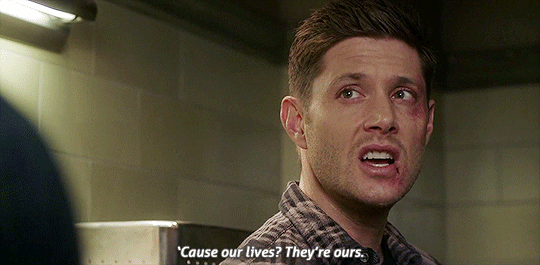
x
Dean ACTUALLY used his words and disclosed the sources of his trauma and parental neglect *screams* He self-introspected during the dishwashing scene in the kitchen -- the Heart and Home -- by precisely doing what we expected/hoped for him (and Sam) to do: reflecting on their current lives in response to 2003!John Winchester’s resurrection and determining what really holds true value and worth...what holds more fulfilling love and true heart’s desires than a pearl ever could --> Found Family.
DEAN, recalling that life is short, accepted his current respective life with Cas and Jack and stressed the self-fulfilling importance of why their lives turned out as such. What they went through since Mary died in 1983 moulded them into who they are today.
HE ACCEPTS WHO HE IS!!
Dean accepts who Sam is.
Sam and Dean, as grown men, become the optimum versions of themselves where their physical, emotional and mental suffering was, of course, undeserved, but also ultimate self-cathartic blessings in disguise: it contributed to their both their psychological resistance and individual journeys towards self-actualization as they create interpersonal bonds with others outside themselves. THEY LET GO.
JOHN: I'm so proud of you boys. I love you both...so much.
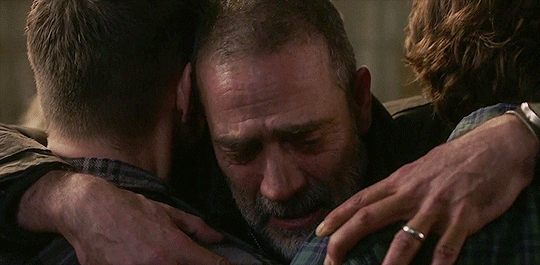

x
THE LONG-WANTED AND LONG-OVERDUE PRIDE AND VERBALIZED LOVE FROM A FATHER WHO ABUSED HIS SONS FOR YEARS. He finally told Sam and Dean that he loved them. He asked for forgiveness, and they freely chose to give it, additionally permitting themselves to embrace cathartic closure. Now THAT is how you transform trauma into your self-motivational strength!!
In particular, we knew *points at all the extensive John vs Dean meta* that Dean yearned to hear those direct words from John. He yearned for years. For Dean to hear it spill out of John’s actual lips -- to hear John verbalize how much he loves Dean, how he’s proud of the man he has become -- after everything Dean has done for him -- is sheer meta fulfillment executed in the most emotive way. Instead of watching his son die without fostering altruism e.g. 2x01 In My Time of Dying, we see John watching his son LIVE and grow -- exercising his agency, formulating decisions for himself, and finally discovering SELF-WORTHINESS. SELF-LOVE. SELF-ACCEPTANCE.
John also told Dean that he “never meant for this. I guess I hoped that eventually you'll get yourself a normal life. A peaceful life. A family.” Well--
Dean told John he does in fact have a family, topped off with the smile of utter happiness on his face.
He chose his own timeline in which Cas and Jack exist. He chose his Found Family.

x
It’s intriguing to note that, in the context of John hoping Dean would have “eventually” obtained a “normal life” -- a “family” -- for himself, if we go off SPN’s constantly-reiterated narrative differentiations between familial family (brothers) and intimate family (husbands, boyfriends, girlfriend) aka Love and...Love, the unsaid connotation of ROMANTIC family applies here, as @thetwistedwillow and I discussed. Sam is Dean’s family, but John isn’t referring to him.
John is referring to Dean getting himself an Apple Pie Life™ -- one that Dean initially tried with Lisa and Ben Braeden but couldn’t sustain; Dean seeking marital happiness outside The Life™ was NOT personally/characteristically feasible. It entailed burying vital truths about himself -- imprisoning his non-performativity -- as a broken man within a broad illusion of Want vs Need whom Lisa also tried and failed to fix...failed to make whole despite Dean once telling her that she comprised his happiness long ago.
Indeed, the present era of Season Cyclic 14 ushers in truth.
Dean has a family with “someone who understands The Life™.”
This aforementioned Life™ -- regardless of it being full of pain, horror, and death -- offers Dean joy, security, and new beginnings.
Cas and Jack, willingly choosing to incorporate themselves into The Life™, are the mirrors of freedom to Lisa and Ben’s jagged misfortunes.
They accept who Dean is wholeheartedly. They lend him purpose, zeal, and love -- buckets of love. They are aware of his faults. They encourage his strengths. They represent his faith and his hope.
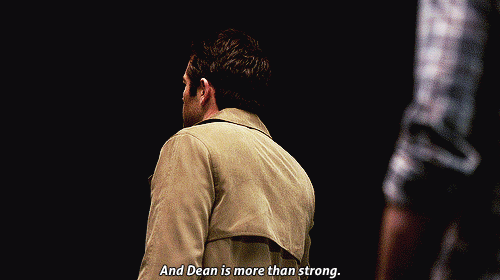
(Cas, more than anyone, is indelibly aware of Dean’s capabilities.)
In terms of communication, Dean told his brother Sam that he loves him in 14x11 [for attempting to find another way re: Michael]. He directly told his mother Mary that he loves her in 12x22. Tonight he finally told his father John that he loves him, too. ALL the emotional honesty and transparency, my friends!!
Who else is left for Dean to say such significant words to? WE JUST DON’T KNOW!
- - - -
14x13 practically crossed off most of this + my entire SPN300 checklist!!!
- CHOSEN FAMILY VS FOUND FAMILY themes
- S14 Dean encountering/hearing about the Castiel of Old—the Angel of the Lord who hasn’t yet built a trustful and ever-complex ten-year relationship with him
- Sam finally rectifying and clarifying things with John as a grown man!!
TPTB know what 14x13’s premise means for Mary Winchester and TFW’s characteristic arcs aka EMOTIONAL CHARACTER-DRIVEN NARRATIVES. They are facing their pasts and must subsequently introspect and FINALLY act upon their WANTS vs NEEDS. Bros (Dean the Emotional Hero of SPN in particular) may have wished John was alive, but is it worth losing Cas and Jack?
- Is it worth losing the real Cas Dean knows? Worth replacing the angel who executed his own choice to Fall, embodied his newfound humanized principles and willingly became part of Dean’s life?
- (And here the focal point of the Destiel-adjacent 14x13 narrative comes in) If John didn’t die, Dean’s life course progression towards self-actualization (with Cas as a key aspect of his psychological realizations; Dean and Cas as both each other’s offsets to healthy self-process) wouldn’t have happened. Losing Mary—losing John—ALLOWED Dean to, despite all the unfortunate circumstances, endure necessary pain in order to heal…to: A. release himself from the shackles of predeterminism, Brodependency, parental absenteeism, repression, toxic misemotionality, and trauma + eliminating the old perceptions of himself as a blunt tool: his father’s hammer and society’s hammer and B. embrace his reflection that he sees in the mirror of his identity
- Is alive!John truly what Dean WANTS? What he NEEDS? Dean and Sam, confronted by personal ultimatum in terms of their individual relationships with John and the psychological states/growth stages his death left him in, must decide!
- TL;DR character development
- And, of course, proliferation of endgame Destiel in some way (not a BIG way yet, but building blocks) from this point onwards and subtext moving into its final pre-text phase as I hope/expect Dean to choose his reality with Cas
(I’m expanding on the last point in a bit!!)
I have LOTS of additional thoughts (tbh they’re all an incoherent jumble lol), but as of now I’d like to say that nothing else can surpass the heartwarming satisfaction that bloomed in my chest over the way Dabb and Glynn beautifully interweaved the narrative’s Family/Love/Forgiveness/Self themes into an episode full of amusing callbacks e.g. Plucky Pennywhistle’s Magical Menagerie (there were a LOT of easter eggs I tell you) and heavy-weighing characteristic ones e.g. Goodbye Stranger Destiel redux -- and oh my gosh, the Dean and Cas narrative callbacks we received tonight, where Dean couldn’t believe that OG Cas had NO recollection of him?!
I don’t know about you, but the romantic subtext smacked me in the face; the negative spaces and unsaid verbalizations were glaring. I was, quite frankly, thumping the table in excitement, because alongside the explicit and gorgeously done Lazarus Rising redux scene -- in a PIZZERIA no less *gestures at Cas = Pizza D/C bonding meta and romantic connotations* -- Sam and Dean confronting OG Cas depicted Dean and Cas' current relationship and dual growth reverting to zero in this AU.
It was a painful encapsulation of the unstable past vs healthy present.
Castiel the Angel of the Lord was non-humanized and never saved Dean from Hell. Emotional detachment and warrior-obedient violence resurfaced as his characteristic markers.



x
Dean, whom Cas -- from the point of first contact in realtime canon -- forged a profound bond with (the bond that proliferated into an intrinsically complex underlying romance narrative which worldwide audiences have been devoutly privy to) was struck by harrowing shock here, and TPTB took intentional liberties to visually fixate on Dean. Sam, on the other hand, reacted via wariness, and he was placed in the periphery -- blurred out to juxtapose their varied emotions of brother and husband; one of these is, as per usual, not like the other.
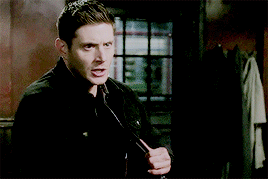
x
Dean realizes the integral role Cas currently holds in his life -- how far they’ve come together, in that the Goodbye Stranger parallel scene between him and Cas has him begging for Cas to stop -- to no avail -- and my heart lurched awfully when Cas made no move to do so. Dean fails in breaking his personal Naomi bred-reminiscent Soldier coding because we all know this certain iteration of Cas never freely chose Humanity.
He never Fell, never embodied the human principles of free will/autonomy and self-identity, never found kinship, and never fell in love with Dean.
Keeping the above in mind, when the real Cas comes back to the bunker after the ever-palpable and necessary self-catharsis that occurred during his absence, TPTB’s narrative brings the episode’s thematic premise of WANT vs NEED full circle as Mary, Sam, and Dean witness his entrance.
Sam and Mary are awed after the temporal fracture ordeal they just experienced, but there lies, once again, a certain cinematographic focus on (12x19-reminiscent) Dean.

x


x
We observe Dean’s onscreen expression of raw appreciation and self-conviction in that he has realized, amongst the throes of meta-laden cathartic self-acceptance, that everything he encountered since childhood -- the good, bad, in-between -- was worth it. This current canon reality is his heart’s deepest desire. He accepts it. He WANTS it.
For Dean Winchester, a life without Cas is no life at all.
RATING: 10/10
#omg I'm sure I forget other certain details but AHH#supernatural#spn s14#14x13#destiel#the greatest love story ever told#CATHARSIS#hunters in love#romance tropes#sam winchester#dean winchester#mary winchester#team free will#tfw#jack winchester#my stuff#my meta#CHARACTER DEVELOPMENT#john winchester's a+ parenting#dean is in love with cas#BROTHER VS HUSBAND#LOVE AND...LOVE#endgame destiel#textual destiel#THIS IS A DABB APPRECIATION BLOG#this is a GLYNN APPRECIATION BLOG#THIS IS A WANEK APPRECIATION BLOG#an EVERYTHING blog tbh lol#long post for ts#FAMILY IS UNITY
476 notes
·
View notes
Text
Podcast Transcript May 16, 2019
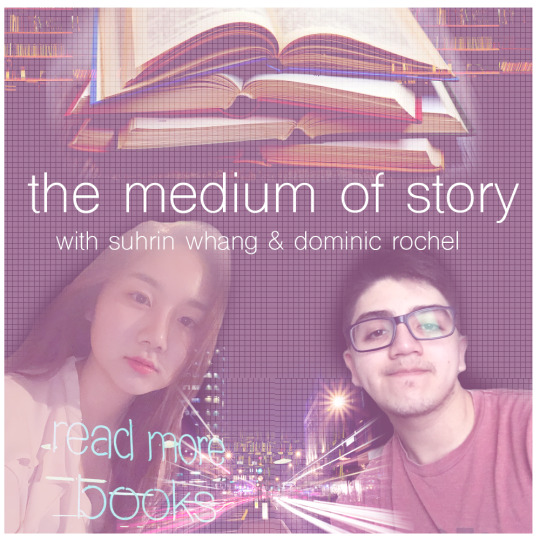
[Podcast Introduction Music]
Suhrin: Hello everyone! You have your two favorite literary critics here. Today we’re going to discuss one of Oprah’s favorite romance novel of all time! I’m your host Suhrin and this is my co-host..
Dominic: Dominic!
Suhrin: Yeah, so. Have you ever read Zora Neale Hurston’s Their Eyes Were Watching God? Or perhaps ever seen the movie?
Dominic: Well, it so happens to be one of my favorite novels of all time. The story is so compelling in the way that it evocatively portrayes all these loaded but profound themes of slavery, racism, and feminism, among others. But, the movie seems to be lacking in many of these themes, you know what they say. If you love the book, don’t watch the movie. Unless you like being angry… Can’t forget the whole Percy Jackson debachuel.
Suhrin: It is really interesting that you mention that, because I wanted to talk about comparing and contrasting the film and the novel in terms of those themes! In fact, I wanted to sort of break down those themes and discuss the intent and the effect of these themes and the way these two mediums—the novel and the film—differ.
Dominic: Well, let’s get into it then. For starters, I think it’s worth exploring how the institution of slavery is portrayed in the novel. When Janie gets married to Joe Starks he claims a black town as his own and decides that he will become the mayor. He makes grand accomplishments in the town by erecting buildings, lamp posts, a store, and just about all the essentials for your very own town start-up. He seems like a great leader who gets things done, but there were, however, talk of people being underpaid in the town for their manual labor and some being left hungry. It really highlights how Joe Starks does not value the townspeople in terms of human decency—as we see through their low wages—but definitely not as much as he values his own voice.
Suhrin: Yeah, I agree with that. I would say it sort of mimics the way slave owners would use their slaves for advancement of their plantation with cruel treatment. It creates a parallel with the institution of slavery, really. I also wanted to go back on what you said about trying to claim the town as his own. It’s reminiscent of how the Puritans came to the United States and claimed the land as their own, there’s a colonial ideal that Joe Starks seems to embody, despite being a black man. Similarly, Joe Starks claims to “help the townspeople”, but treats them in an unfair way which parallels the way Puritans treated Native Americans. They used them for their land, resources, labor, and basically exploited them while simultaneously preparing them for slaughter. Of course, Joe Starks doesn’t kill anyone outright, except maybe Janie, metaphorically. He oppresses her, he enslaves her in their marriage, and he confines her to female gender roles and imprisons her in the store, where she spends the majority of her days removed from her community. So I think this all speaks to the idea of slavery, colonization, and the oppressive forces these bring.
Dominic: Yeah, I really like that comparison... There’s something deeply intrinsic in the black experience of oppression that seems to harken back to the relatively recent evil of slavery, even with her relationship with Teacake, there’s a specific part in the novel that helps build on this theme of slavery. Remember the scene where Teacake whips Janie? He describes that he needs to relieve “that awful fear inside him” and that “being able to whip her reassured him in possession,” (Hurston 147). I think this is just so wrong and definitely alludes to slavery.
Suhrin: I agree. It definitely parallels with the aspect of how slave owners would whip their slaves as punishment but also to represent their ownership over them. I think later on in the scene other people watch Teacake “punish” his woman and they praise him. It relates to how slaveholders would publicly abuse their slaves to represent their possession and wealth. The whipping is a tool of oppression, it breaks their will and resilience, crushes the spirit, and incites fear. It encourages the manufacturing of a glassy-eyed autonomous robot workforce, devoid of humanity, it being whipped right out of them.
Dominic: I guess this leaves us with this burning question: just what was Hurston’s intent here? What implications does this evocation of the institution of slavery have? I think it’s definitely speaking to how this terrible thing—institutionalized slavery—how even then the black community felt the beginnings of what would be a long lasting effect on African American life. The impact of slavery and the ripples it made in the world, in our everyday lives when we go out into society and interact with black people, it’s all stemming from this awful thing that was happening for hundreds of years. And I think the way their actions in the novel mimic the cruel actions of slavery, and the fact that it’s black people doing it to black people, it represents how they internalized those emotions and experiences, and through intergenerational trauma it shapes their lives even after, it marks their character with the effects of the ripples-turned-waves of slavery.
Their ancestors faced this cruel treatment and maybe subconsciously they emulated this treatment with their children since these experiences have stained their blood, their skin, their very souls. It also explores this larger idea of slavery not being just about white and black relations, but the lasting effects of post-slavery that still lingers within black communities.
Suhrin: Hurston is maybe trying to show a little sympathy to these African American characters that act in this manner due to the intergenerational trauma, but it does not mean that it is still justified. I think the way that the novel ends with both husbands dying shows sort of how their actions should still be met with an equal punishment. Slave owners will get what’s coming to them.
Dominic: That’s a bit cutthroat, but maybe! I think one thing for certain is that the novel explores this theme of slavery in a deep manner where it gets the reader to think about this cyclical system and its impact. As for the film, I don’t think this theme was adequately portrayed or explored. Sure we see Joe Starks create the town like in the novel, but the very real problems of underpaid labor and starving people are cut from the film. The film works hard to not portray him in a negative light in this way, and in doing so it makes his character less dynamic and minimizes the complexity of Janie’s struggle with identity as she buckles under the weight of his oppression. Also, they conveniently leave out the part where Teacake whips Janie. What appears to be minor details in the novel that are consciously left out by the filmmakers really makes a huge difference. I think the message gets lost somewhere in the translation from novel to film. We don’t see how institutionalized slavery affects the African American community, or more specifically Janie, and in leaving this out, the filmmakers fail to adequately portray Janie’s struggle with coming to terms with her identity as someone who’s black, someone whose grandmother was a slave, and someone who’s a woman.
Suhrin: I think so too. And I feel like we can’t talk about this theme of slavery without exploring the other racial undertones in the novel. For me, I think that the portrayal of racism is greatly focused in the novel specifically with Mrs. Turner. She is described as this woman with European features and praises Janie greatly for her own superior European aspects as well, romanticizing her light skin. It’s interesting how she describes Janie and herself as superior to the other members of the community due to the fact that they are “less black”. It really represents the idea of racism and specifically colorism. It’s interesting how Mrs. Turner conceives race though, it’s very hierarchical and rigid, offering little mobility upwards. You’re born into your lot, your caste, and you have a duty to act a certain way, going so far as to justify her belittlement and blatant colorism on this same power structure. The blacker you are, the worse you deserve to be treated. The whiter you are, the greater the need to treat those below you more terribly to make it known it’s not okay to be dark, to make them resent themselves for being black in hopes of somehow bringing an end to the race overall. In destroying their self-worth, Mrs. Turner hopes to discourage the propagation of the black community. She even offers Janie to be with her brother because he is not as dark as Teacake. It’s this idea that they need to dilute the dark melanin in black people to preserve this sense of superiority inherent to white skin.
Dominic: You know, I like what you’re saying here, these are some very astute observations. If we’re thinking about what Hurston’s thinking about as she wrote Their Eyes Were Watching God, the intention seems to be to represent this issue revolving around racism as something larger than blatant nastiness, but something more sinister and insidious that works itself into the minds of black and mixed people too, not just white people. It’s a disease that takes form in the shape of the internalized racism that’s ingrained in these communities and propagated like a virus spreading. Because Mrs. Turner is still a black women, she may be passing for a white women, or conceptualize herself in the realm of white identity, but she’s still also black. And it’s so sad to see the lengths she goes to to spread hate and misery.
Suhrin: That’s a sharp contrast to the movie, I think, we never hear or see any mention of Mrs. Turner’s character in the film. Perhaps it’s because they thought the inclusion of her character was a minor detail, but I really don’t think so. Her absence from the narrative leaves out important commentary on internalized racism and the toxicity of colorism.
Dominic: Mrs. Turner is especially crucial to Janie’s journey to self-discovery and identity. I read an analytical article by this scholar, Lihua Zhao, and she writes this wonderful piece on how Janie suppresses race and racial issues until Mrs. Turner forces her to confront them. Throughout the novel, we see Janie traversing the American South, and she rides trains and marvels at the beauty of the world. She goes on all these outings to restaurants and social spaces where Jim Crow laws are likely in place, since the South is most definitely still segregated in Janie’s world, but she never acknowledges it.
There’s different compartments for black and white folks on trains, there’s different restrooms, sometimes they’re barred from entire establishments based on their skin color, and not once do we see Janie speak to this. Zhao explains how this shows Janie’s alienation from black society and her denial of her black identity. I think this is a super interesting idea, considering the novel opens with Janie growing up among white children, not knowing she’s black until she’s shown a picture of herself.
Suhrin: That’s so interesting, it reminds me of this duality that seems to be essential to Janie’s character. I’m glad they didn’t cut that out of the movie, where Janie says she learns to portray herself and act a certain way externally, but her mind and her feelings are kept inside as she erects a wall between her internal and external worlds. And then this weird juxtaposition creeps in with her second husband, Joe Starks. He begins treating her like something other, and the townspeople follow suit. This idolization of the black woman was a much larger, more central issue in the novel than in the film.
Dominic: In the novel we also get a nice inversion of the meaning of the color black. She starts wearing black when Joe dies, but when Joe is alive and idolizing her, her black racial identity is essentially erased by this problematic idea of racial uplifting. Her black skin does not connote blackness for her, but the illusion of something more, conflating her status to that of a white woman. And on the exterior, Janie would put on a façade to appease Joe and the black community he represents that wants to put black women on a pedestal. But in Janie’s interior, she longs to partake in the conversations happening on the store’s porch, she wants to attend community events and gatherings not as a trophy wife, but as a regular person having fun and reveling in the sense of community. So, when Joe dies, Janie can finally destroy the wall he placed between her and Eatonville and her interior and exterior. In donning the black to grieve, she’s also reconnecting with her black community. For Janie, it’s not about living a posh leisurely life of a white woman, but living how she wants as a real black women. She finds freedom in Joe’s death, she finds an escape from the burden of having to be the model black woman, the ideal for all other black women to work toward, an ideal that alienated her from the very same race this ideal is striving to uplift.
Suhrin: I completely agree with that interpretation, Janie goes through quite a journey to understand herself and her racial identity. And it’s such a beautiful moment for Janie when she and Tea Cake banish Mrs. Turner from the muck farm, and sadly we don’t get that in the film. In the novel when the cast out Mrs. Turner, it’s as if Janie finds peace with her black identity, her black life, and she knows she has no room in it for the hate Mrs. Turner represents. And in portraying these issues of race and colorism, it allows the reader to be more introspective and think on how we should work to improve these issues in our society today. Because racism, colorism, and internalized-racism are still very real problems people of color face.
Dominic: Very true. The gender dynamics are pretty interesting too, when you compare the novel and the film. In terms of feminism, I think the novel doesn’t really do it much justice. In a way Janie is very submissive to the commands of her husbands. When Joe tells her to put on that head-rag to cover her hair, she sort of reluctantly does so, but she does it. In doing so, he masks her beauty, her stunts her identity, and that visual of putting her hair up and keeping it and her head wrapped up, it feels like he’s metaphorically shackling her mind. But even when she has that moment where she lets down her hair after Joe passes away, it just did not scream feminism to me. I liked that she found freedom in being single and she didn’t really feel the need to grieve Joe, not for long anyway, because he made her feel terrible about her body and herself. But it just felt like I expected more feminist commentary from a book written by a black woman living in the South, where gender norms are stricter than most places. In our contemporary world we’re getting things like female Ghostbusters, explorations of power dynamics and gender roles in TV and literature like The Handmaid’s Tale, and we have female superheroes like Captain Marvel, Wonder Woman, and Scarlett Johansson, who can play just about any race and ethnicity, ha! But seriously, these women are role models and they’re portraying strong individuals and acting as great representation for women and young girls everywhere, and I just expected a little more of that from Their Eyes.
Suhrin: I totally get what you are trying to say. In the movie, she’s definitely more resistant to hiding her hair than she is in the book. When she realizes how Joe is trying to control her and segregate her from the community, she actually makes an attempt to run away and defy him. Then Joe starts screaming that no one will want, just as someone’s plaything, insinuating prostitution even, and Janie quietly, resigned, walks back into their house, and this was really powerful. I think including this scene makes it compelling to the idea that Janie is a strong female character with a strong will, and even then she is trapped in this situation, and we see this visually with her struggle in the film. Also, the moment she lets down her hair seems a whole lot more dramatized. The symbol of how the head rag is a metaphor for the constraint that men put on women seems to be far more prevalent. Maybe it’s because of the medium itself, film being more visual, that the effect feels more pronounced, but it was definitely a more focalized symbol in the movie than the novel.
Dominic: Could this relate to the idea that the movie is geared towards a female audience? I think the film is made so it is palatable for women by highlighting these feminist ideals, ironically in a sexist way. By leaving out these important themes from the novel of slavery and racism in the movie and focusing solely on the romance plotline, while simultaneously altering Janie’s character to portray this more contemporary ideal feminist woman, it feels as if the filmmakers aren’t taking women as seriously as they should. It’s like they’re dumbing down this beautiful piece of literature for an audience—women—whom they think is only interested in watching romance movies where they don’t have to think too much, just feel, as a woman does. There’s no room for explorations of identity, race, and slavery, let other filmmakers and the literature handle that, in the capitalistic world of film they need to produce something that sells, not something that provides scathing social commentary or sheds light on important and prevalent social issues.
Suhrin: Yup, you put it in words. The movie is definitely far more romanticized than the novel. Especially the way that it includes all those steamy sex scenes, and the primary focus is Janie’s search for love. They’re selling sex and romance, and although Janie’s character feels like more of a feminist in the film, I definitely think it’s for all the wrong reasons. What a confusingly hot take though, feminism is sexist in film! You have to take a minute to wrap your head around that, but I think it makes sense when you’re looking at it retrospectively and in terms of intent and purpose. Yes, we love feminist Janie who stands up for herself, yes we wish novel Janie were more like film Janie, but we also wish the film wasn’t butchered to leave out all these important themes and social issues the novel explores in depth.
Suhrin: All in all, slavery and racism is skillfully explored in the novel. The institution of slavery, and later racism, that persis in history have a negative effect on the African American community. It is shown when they partake in or emulate slavery and racism with their own people. It sort of represents the cyclical system that’s so ingrained in our society, but certainly not justified. By doing so, it makes the novel deeper than a love story. The novel doesn’t contain big ideas of feminism strongly, but perhaps it could have been the time period which does not allow for women of color writers to write about such controversial things, or maybe even radical at the time.
Dominic: In contrast, the film does not explore the ideas of slavery and racism, which makes it lacking in depth for me. Sure, romances can be powerful and uplifting and profound, but it’s a heavily gendered genre in film and literature, so I think the film definitely propagates this idea of romance being cheap and low-brow by leaving out all these themes. Nonetheless, the film also tends to have feminism a bit more ingrained in the story. Janie’s resistance to these men trying to control her life and her struggle is clearly portrayed in a feminist light. This highlights the power dynamics in society between men and women, especially back then, with women finding themselves stuck in situations where they’re helpless because they chose to marry the wrong man. But the way that feminism and romance are incorporated makes me believe that it was geared towards a female audience for purely capitalistic motivations.
Suhrin: I recently read an article written by Richard Wright and it discusses how the novel is “cloaked in facile sensuality,” and portrays the minds of “Negro-folk mind in their pure simplicity,”. It’s really interesting he feels this way because I would have to disagree. Yes, I think the novel and the film do not touch on every single theme out there, but they both portray greater ideas that go beyond just mere narrative. There’s so much commentary on society! There’s so much representation for women of color, for women writers, for victims of domestic violence, and for victims of racism, colorism, and internalized-racism. Neither the novel or the film are perfect, but in a meta way, these two mediums for Janie’s story act in conversation to spark more conversation, like the one we’re having now. Both mediums act together to get people thinking, talking, and hopefully to enact change. And for that, I love Hurston’s Their Eyes Were Watching God.
Dominic: Beautifully put Suhrin, I agree wholeheartedly.
Well, it appears that’s all we have time for today. Thanks for joining us as you listen on your way to work, as you drive your kids to school, or maybe just as you cruise down the highway, listening to us ramble. You all be safe out there and enjoy your morning. This has been your co-host, Dominic Rochel, and..
Suhrin: Suhrin Whang! Y’all take care now!
[Podcast Outro Music]
0 notes
Photo
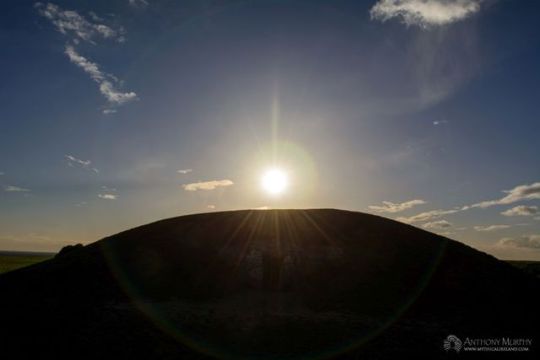


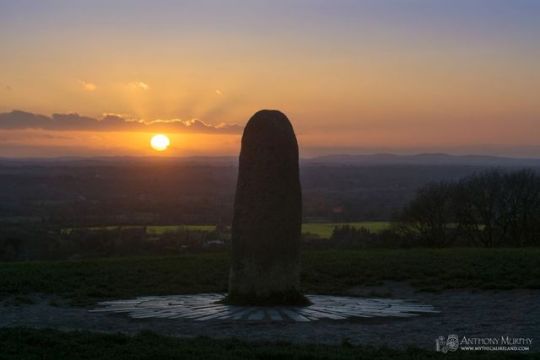
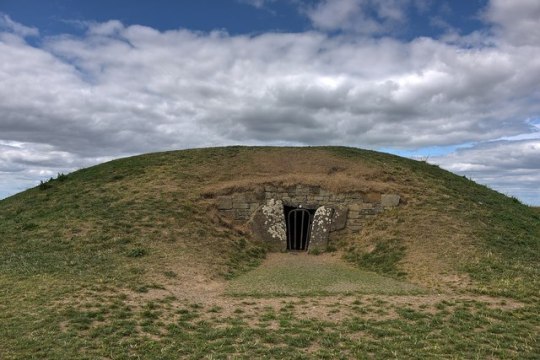

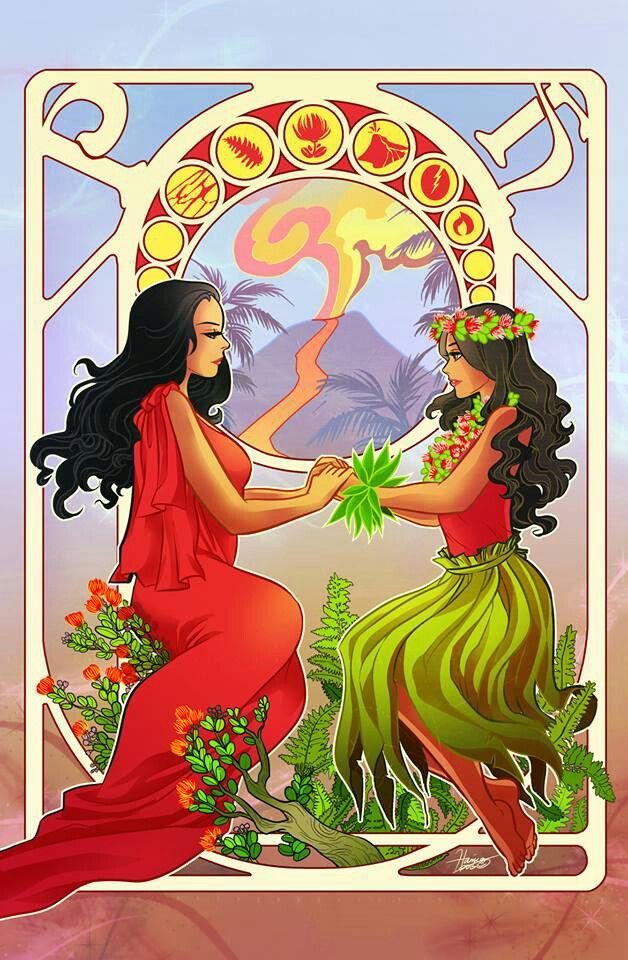
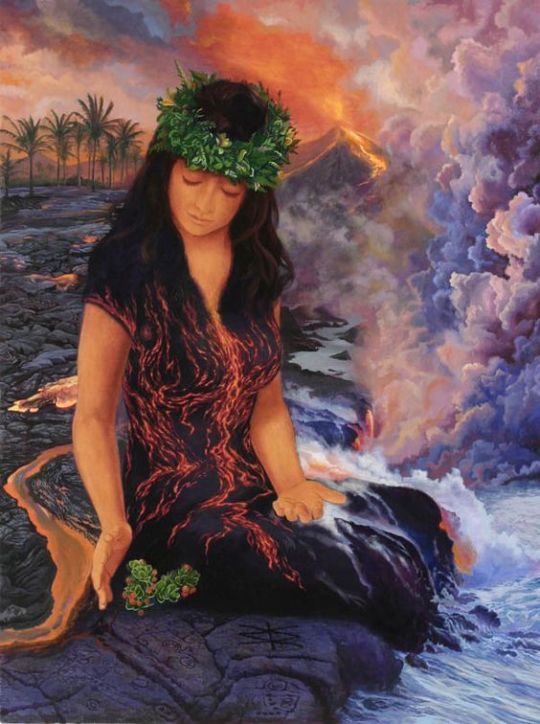

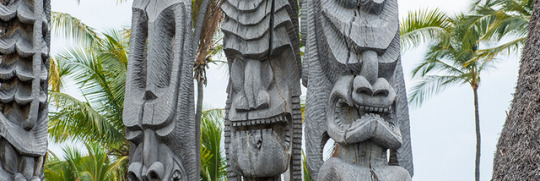
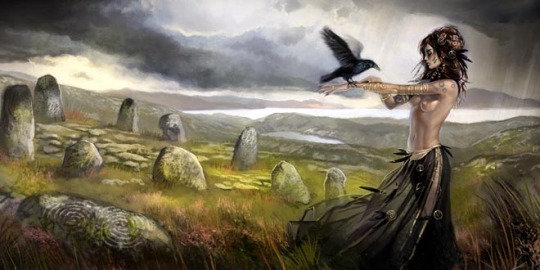
ANCIENT SITES | THE HILL OF TARA – TEAMHAIR
“The Hill of Tara, known as Temair in gaeilge, was once the ancient seat of power in Ireland – 142 kings are said to have reigned there in prehistoric and historic times. In ancient Irish religion and mythology Temair was the sacred place of dwelling for the gods, and was the entrance to the otherworld. Saint Patrick is said to have come to Tara to confront the ancient religion of the pagans at its most powerful site.”

“One interpretation of the name Tara says that it means a "place of great prospect" and indeed on a clear day it is claimed that features in half the counties of Ireland can be seen from atop Tara...Early in the 20th century a group of Israelites came to Tara with the conviction that the Arc of the Covenant was buried in on the famous hill. They dug the Mound of the Synods in search of the Arc but found only some Roman coins.”

“Sitting on top of the King's Seat (Forradh) of Temair is the most famous of Tara's monuments - Ireland's ancient coronation stone - the Lia Fail or "Stone of Destiny", which was brought here according to mythology by the godlike people, the Tuatha Dé Danann, as one of their sacred objects. It was said to roar when touched by the rightful king of Tara.”
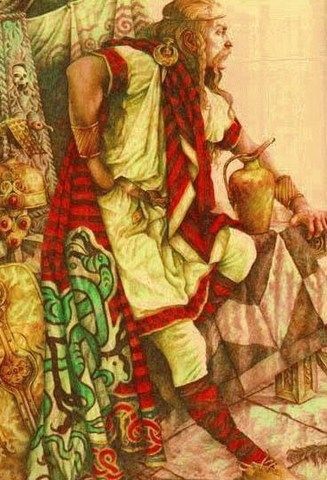
“In the churchyard at Tara there are two standing stones, which are believed to be ancient – remnants of a time when there were many stone monuments on Tara. The taller of the two stones is thought to feature a figure of the Celtic fertility god Cernunnos, and is similar to many of the 'Sheela na Gig' representations found across Ireland. These stones may date to the Neolithic period, although are more likely to have their origin in the Bronze Age.”
(via Mythical Ireland | Ancient Sites | The Hill of Tara – Teamhair)

Terra (mythology)
“In ancient Roman religion and myth, Tellus Mater or Terra Mater ("Mother Earth") is a goddess of the earth...She is regularly associated with Ceres in rituals pertaining to the earth and agricultural fertility...Her Greek counterpartis Gaia...the Terra Mater who appears during the reign of Augustus is a direct transferral of the Greek Ge Mater into Roman religious practice...The word tellus, telluris is also a Latin common noun for "land, territory; earth," as is terra, "earth, ground"...In several modern Romance languages, terra (or French terre) is the name of planet Earth. Following post-classical Latin astronomical terminology, Earth is sometimes referred to as "Terra".”
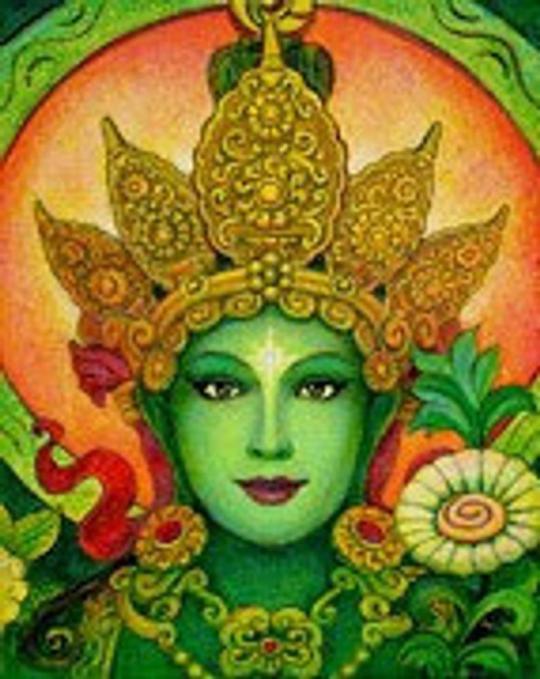
Tara (Buddhism)
“Tara, Ārya Tārā, or White Tara...in Tibetan Buddhism, is an important figure in Buddhism. She appears as a female bodhisattva in Mahayana Buddhism, and as a female Buddha in VajrayanaBuddhism. She is known as the "mother of liberation", and represents the virtues of success in work and achievements. She is known as Tara Bosatsu in Japan, and occasionally as Duōluó Púsà in Chinese Buddhism.
Tārā is a meditation deity worshiped by practitioners of the Tibetan branch of Vajrayana Buddhism to develop certain inner qualities and to understand outer, inner and secret teachings such as karuṇā (compassion), mettā (loving-kindness), and shunyata (emptiness). Tārā may more properly be understood as different aspects of the same quality, as bodhisattvas are often considered metaphors for Buddhist virtues.
Tārā is also known as a saviouress, as a heavenly deity who hears the cries of beings experiencing misery in saṃsāra. Whether the Tārā figure originated as a Buddhist or Hindu goddess is unclear and remains a source of inquiry among scholars. Mallar Ghosh believes her to have originated as a form of the goddess Durga in the Hindu Puranas.”

”She eventually came to be considered the "Mother of all Buddhas," which usually refers to the enlightened wisdom of the Buddhas, while simultaneously echoing the ancient concept of the Mother Goddess in India.
Independent of whether she is classified as a deity, a Buddha, or a bodhisattva, Tārā remains very popular in Tibet (and Tibetan communities in exile in Northern India), Mongolia, Nepal, Bhutan, Sikkim and is worshiped in a majority of Buddhist communities throughout the world.
Today, Green Tara and White Tara are probably the most popular representations of Tara. Green Tara (Khadiravani) is usually associated with protection from fear and the following eight obs-curation: lions (= pride), wild elephants (= delusion/ignorance), fires (= hatred and anger), snakes (= jealousy), bandits and thieves (= wrong views, including fanatical views), bondage (= avarice and miserliness), floods (= desire and attachment), and evil spirits and demons (= deluded doubts).”

”As one of the three deities of long life, White Tara (Saraswati) is associated with longevity. White Tara counteracts illness and thereby helps to bring about a long life. She embodies the motivation that is compassion and is said to be as white and radiant as the moon.
Tārā's name literally means "star" or "planet", and therefore she is associated with navigation and travel both literally and metaphorically as spiritual crossing to the 'other side' of the ocean of existence (enlightenment). Hence she is known literally as "she who saves" in Tibetan. In the 108 Names of the Holy Tara, Tara is 'Leader of the caravans ..... who showeth the way to those who have lost it' and she is named as Dhruva, the Sanskrit name for the North Star.”
Tārā also embodies many of the qualities of feminine principle. She is known as the Mother of Mercy and Compassion. She is the source, the female aspect of the universe, which gives birth to warmth, compassion and relief from bad karma as experienced by ordinary beings in cyclic existence. She engenders, nourishes, smiles at the vitality of creation, and has sympathy for all beings as a mother does for her children.”
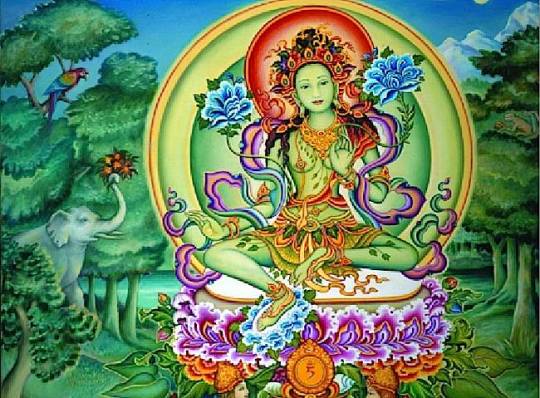
“As Green Tārā she offers succor and protection from all the unfortunate circumstances one can encounter within the samsaric world. As White Tārā she expresses maternal compassion and offers healing to beings who are hurt or wounded, either mentally or psychically. As Red Tārā she teaches discriminating awareness about created phenomena, and how to turn raw desire into compassion and love. As Blue Tārā (Ekajati) she becomes a protector in the Nyingma lineage, who expresses a ferocious, wrathful, female energy whose invocation destroys all Dharmic obstacles and engenders good luck.
Another quality of feminine principle which she shares with the dakinis is playfulness...Tārā is frequently depicted as a young sixteen-year-old girlish woman. She often manifests in the lives of dharma practitioners when they take themselves, or the spiritual path too seriously. There are Tibetan tales in which she laughs at self-righteousness, or plays pranks on those who lack reverence for the feminine. In Magic Dance: The Display of the Self-Nature of the Five Wisdom Dakinis...her playful mind can relieve ordinary minds which become rigidly serious or tightly gripped by dualistic distinctions. She takes delight in an open mind and a receptive heart then. For in this openness and receptivity her blessings can naturally unfold and her energies can quicken the aspirants spiritual development.”
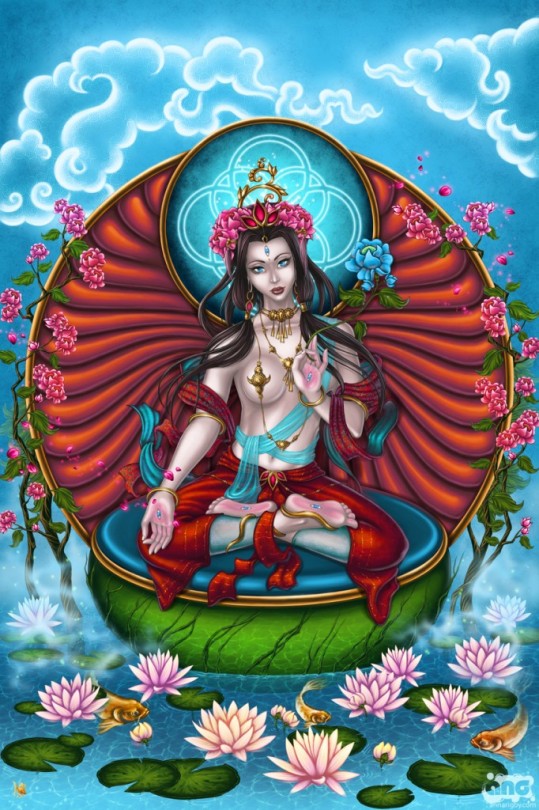
Polynesian narrative
“The Polynesian narrative or Polynesian mythology encompasses the oral traditions of the people of Polynesia, a grouping of Central and South Pacific Ocean island archipelagos...Prior to the 15th century AD, Polynesian peoples fanned out to the east, to the Cook Islands, and from there to other groups such as Tahiti and the Marquesas. Their descendants later discovered the islands from Tahiti to Rapa Nui, and later Hawai‘i and New Zealand. Latest research puts the settlement of New Zealand at about 1300 AD.”

”In some island groups, help is of great importance as the god of the sea and of fishing. There is often a story of the marriage between Sky and Earth; the New Zealand version, Rangi and Papa, is a union that gives birth to the world and all things in it. There are stories of islands pulled up from the bottom of the sea by a magic fishhook, or thrown down from heaven. There are stories of voyages, migrations, seductions and battles, as one might expect. Stories about a trickster, Māui, are widely known, as are those about a beautiful goddess/ancestress Hina or Sina.
In addition to these shared themes in the oral tradition, each island group has its own stories of demi-gods and culture heroes, shading gradually into the firmer outlines of remembered history. Often such stories were linked to various geographic or ecological features, which may be described as the petrified remains of the supernatural beings.”
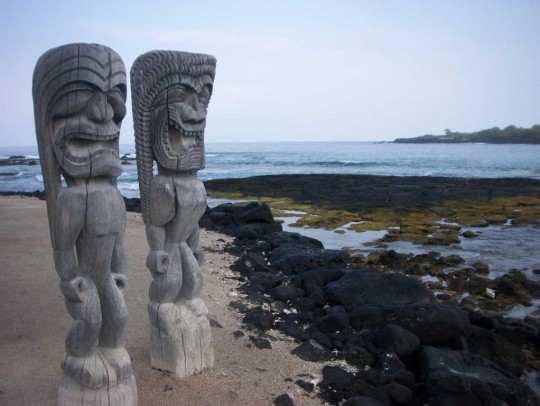
Tiki
“In Māori mythology, Tiki is the first man created by either Tūmatauenga or Tāne. He found the first woman, Marikoriko, in a pond; she seduced him and he became the father of Hine-kau-ataata. By extension, a tiki is a large or small wooden or stone carving in humanoid form...In some West Coast versions, Tiki himself, as a son of Rangi and Papa, creates the first human by mixing his own blood with clay, and Tāne then makes the first woman. Sometimes Tūmatauenga, the war god, creates Tiki. In another story the first woman is Mārikoriko. Tiki marries her and their daughter is Hine-kau-ataata. In some traditions, Tiki is the penis of Tāne. In fact, Tiki is strongly associated with the origin of the reproductive act.“
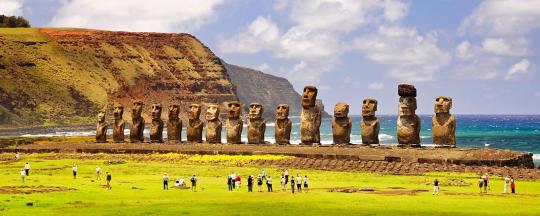
“In one story of Tiki among the many variants, Tiki was lonely and craved company. One day, seeing his reflection in a pool, he thought he had found a companion, and dove into the pool to seize it. The image shattered and Tiki was disappointed. He fell asleep and when he awoke he saw the reflection again. He covered the pool with earth and it gave birth to a woman. Tiki lived with her in serenity, until one day the woman was excited by an eel. Her excitement passed to Tiki and the first reproductive act resulted.
The word appears as tiki in New Zealand Māori, Cook Islands Māori, Tuamotuan, and Marquesan; as tiʻi in Tahitian, and as kiʻi in Hawaiian...In the Cook Islands...Tiki is the guardian of the entrance to Avaiki, the underworld...The entrance to Avaiki (the underworld) is called ‘the chasm of Tiki’.”
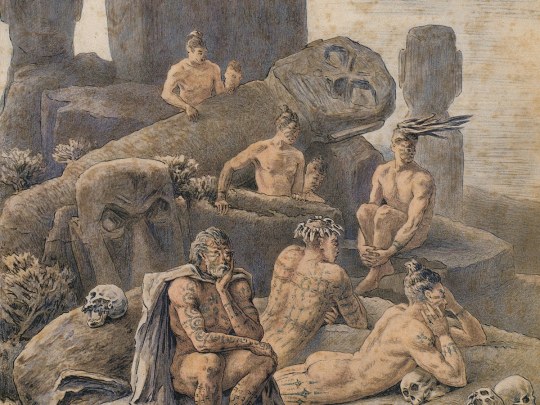
What Is the Meaning of Tiki statues?
“Tiki statues were originally carved by members of the Maori tribe as boundary markers for sacred grounds. The name of the statues is derived from the Maori name for the first human male, though the statues most often represent deities. With the introduction of missionaries into Hawaiian society in the early 1800s, Christianity became the dominant religion. Tiki statues have since lost much of their original meaning aside from their historical significance.”
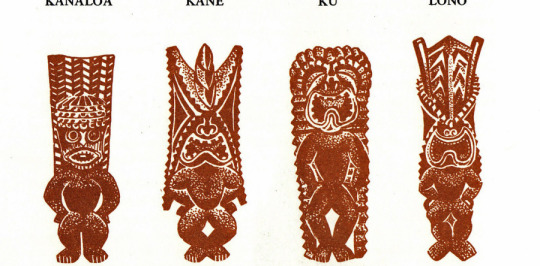
“The statues most commonly represent one of the four significant gods in Hawaiian culture: Kane, Ku, Lono and Kanaloa. Kane is considered the creator of the universe and the ruler of the natural world. Ku is the Hawaiian god of war...Lono is the god of rain and fertility, as well as music and peace. Kanaloa is the god of the sea...A Lono statue is identified by its large, “fertile” belly and jovial smile.
The Ki'i statue at Pu'uhonua o Honauna National Historical Park is one of the largest and most visited Tiki statues in Hawaii. The statue rests at the entrance of a recreated Maori village. The statue is of Tiki, the first human, which explains its humanoid appearance.”

Ti'iti'i
“In Samoan legend, the mythological figure Ti'iti'i appears in legends very similar to those recounting the tales of the demigod Māui, found in other island cultures. In one such legend, which is almost identical to the New Zealand fire myth of Māui, he succeeds in bringing fire to the people of Samoa after a battle with the earthquake god, Mafui'e.
In Polynesian spellings, 't' and 'k' are linguistically linked, and in speech, the 'k' sound is typically used in place of the 't' sound. Likewise, the apostrophe can be used to replace either sounds. Thus, the Samoan Ti'iti'i is comparable to the Gilbert Islands' Tiki-tiki, or Hawai'ian Maui-ki'i-ki'i.”

Rangi and Papa
“In Māori mythology the primal couple Rangi and Papa (or Ranginui and Papatūānuku) appear in a creation myth explaining the origin of the world...In some South Island dialects, Rangi is called Raki or Rakinui...are the primordial parents, the sky father and the earth mother who lie locked together in a tight embrace. They have many children...

“Ranginui
Rangi ("Sky")
Raki ("Sky") in the South Island
Ranginui ("Great Sky")
Rangi-pōtiki ("Rangi the Lastborn"): possibly another name of Rangi, or a closely allied deity”
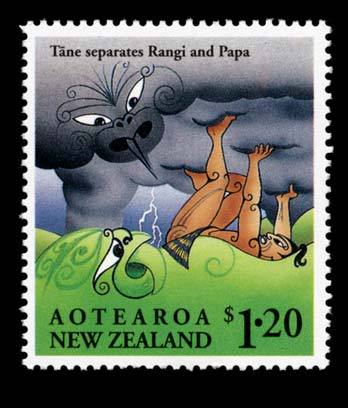
”Papatuanuku
Papa ("world")
Papatūānuku ("world separated"), (Earth), (Mother Earth)
Atea, husband of Papa (primordial parents) in Tuamotuan, Rarotongan and Marquesas genealogies
Wākea, husband of Papa, from Hawaii
Vatea, husband of Papa, father of gods and men in Mangaia, Cook Islands
Anu and Ki, Sumerian deities similar to Rangi and Papa
Uranus and Gæa, Greek deities similar to Rangi and Papa
Dyaúṣ-pitṛ and Pṛthvī-mātṛ, Vedic deities similar to Rangi and Papa”

Hawaiian religion
“Hawaiian religion encompasses the indigenous religious beliefs and practices of the Native Hawaiians. It is polytheistic and animistic, with a belief in many deities and spirits, including the belief that spirits are found in non-human beings and objects such as animals, the waves, and the sky.Hawaiian religion originated among the Tahitians and other Pacific islanders who landed in Hawaiʻi between 500 and 1300 AD.”
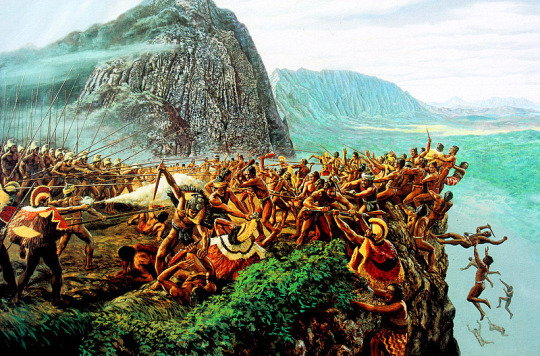
“One Hawaiian creation myth is embodied in the Kumulipo, an epic chant linking the aliʻi, or Hawaiian royalty, to the gods...After the birth of Laʻilaʻi, the woman, and Kiʻi, the man, the man succeeds at seducing and reproducing with the woman before the god Kāne has a chance, thereby making the divine lineage of the gods younger than and thus subservient to the lineage of man. This, in turn, illustrates the transition of mankind from being symbols for the gods (the literal meaning of kiʻi) into the keeper of these symbols in the form of idols and the like. The Kumulipo was recited during the time of Makahiki, to honor the god of fertility, Lono.”

THE HOME OF THE ANCESTORS
“The ancestors of the New Zealand Maoris have a definite ancestral home from which they came to New Zealand. This bears the name Hawaiki which is the same as Hawai'i...The Hawaiians, however, had one word for all outside lands. This was Kahiki or Tahiti. If any one sailed to any far-away place, east or west, he went to Kahiki...Ke-alohi-lani (the shining or glorious heaven) was the where the vivid imagination placed all things beautiful. It was the ancient land to be desired. Another interpretation, however, makes it the land of shining clouds, probably lit by volcanic fires, reflecting the glory of the burning flames.”

Hawaiki
“Hawaiki is the traditional Māori place of origin. The first Māori are said to have sailed to New Zealand from Hawaiki. And in Māori mythology Hawaiki is the place where Io, the supreme being, created the world and its first people...Hawaiki represents all that is good and powerful. It is a mystical place, where people turn into birds or descend to the underworld...In some traditions, the supreme being Io created Hawaiki. The gods are believed to live there, including the trickster demigod Māui, whose deeds are famous throughout Polynesia. The first woman, Hineahuone, was fashioned from the soil of Hawaiki.”

“S. Percy Smith...In his book Hawaiki, the original homeland of the Maori (1904), Smith advanced his theories as to the physical location of Hawaiki. He suggested that islands such as Savai‘i in Samoa, Hawaii and even Java near Indonesia were actually Hawaiki in localised forms...Some writers went further, arguing that Māori origins could be found in India and even Mesopotamia, the ancient region of present-day Iraq. Alfred K. Newman’s Who are the Maoris? (1912) is an example of a work that argues for the Indian origins of Māori people.”

(via Hawaiki | Te Ara: The Encyclopedia of New Zealand)

#hilloftara#irishgoddess#stpatrick#terramater#motherearth#buddhistgoddesstara#mothergoddess#fertilitygod&godess#polynesianislands#rangi&papa#tiki#hawaiki#tiitii#kiikii#tahiti#kahiki#kii&lailai#1stman&woman#hawaiianmythology
0 notes
Text
The Endless Generosity of Kyoto Animation
This article is part of Crunchyroll News' KyoAni Month celebration. Check out the rest of our KyoAni features HERE.
When we discuss the anime that most appeal to us, we often default to discussing them in pure narrative terms — the exciting events that transpired, the character turns that most shocked us, or whatever else felt momentous and novel over the course of the narrative. This is understandable; it’s much easier to retell a story than to convey a production’s atmosphere or aesthetic appeal. And for most people, a narrative elevator pitch is generally a useful way to determine whether something will appeal to them. As human beings, we love stories — and distilled into their most elemental format, stories are a progression of plot events, a journey from one point to another.
Unfortunately, this method of describing anime is not particularly useful for capturing the appeal of Kyoto Animation’s productions. As a studio lauded for their collaborative atmosphere and progressive labor practices, Kyoto Animation’s productions are always, like all great, cohesive art, more than the sum of their parts. Their power resides in how their directors, storyboarders, and animators capture the experience of truly living inside a moment. The skew of the dying sunlight, the distant hum of traffic, the particular glimmer in a person’s eye — it is these tiny, indescribable details that turn narrative beats into lived experience, and it is these things that set Kyoto Animation apart within the anime industry.
As someone who’s always been more inspired by tone, themes, and individual characters than strict narrative beats, Kyoto Animation is more than an inspiration to me. Through their works, the studio has taught me to better understand what moves me within art, and the incredible power of capturing a single convincing, emotionally rich moment. Kyoto Animation’s works have expanded my understanding of what art should strive for, and the myriad ways a talented, passionate team of artists can elevate narrative into astonishing beauty and emotional catharsis. As we celebrate this very special studio, today I’d like to share how just a few of their productions embody that power for me.
K-On!: The Beauty of a Warm, Sunlit Room
Before watching K-On!, I didn’t really understand the appeal of slice-of-life anime. I could get into them if their joke density was high enough, but it rarely was — generally, they were more “pleasant” than actively funny, leaving me mostly bored. But watching K-On! made their appeal seem completely obvious — through its beautiful, inviting backgrounds, charming characters, and playful, restless animation, it felt easy to join in the warm, relaxing atmosphere of an after-school band club.
Naoko Yamada has since gone on to become one of the premiere anime directors of the 21st century, but even her very first show demonstrated the mastery of atmosphere and reverence for quirky, incidental character moments that give her stories such life. For me, K-On! embodies the holistic approach to writing, directing, animating, and scoring that can make anime so uniquely powerful. It contains a warmth and kindness that is reflected in its every aspect, a gentleness that makes it easy to wrap around yourself like a snug blanket.
Nichijou: The Magnificence of a Joke Fully Told
There are no shortage of anime that tell lots of jokes, but I don’t think I’ve ever seen a show that commits to its jokes as fully, creatively, and energetically as Nichijou. Just as Kyoto Animation’s overall portfolio demonstrates the importance of cohesive, inspired execution in elevating base narrative substance, so does Nichijou specifically demonstrate that when it comes to comedy, execution is everything. Nichijou’s diversity of visual styles and fluidity of movement is incredible, and the show is incredibly generous in terms of where it flexes its powers — it will dedicate gorgeous, energetic animation to the silliest of ideas, resulting in transcendent moments like a school principal suplexing an angry deer.
Hyouka: The Complexity of Our Ever-Changing Youth
Among all Kyoto Animation productions, I’d name Hyouka as the one with the strongest, most ambitious script. Its characters evolve in countless subtle ways across their adventures, and the show catalogs all these changes with empathy and grace. Hyouka’s subtle, everyday mysteries act as a mirror for these changes. After all, it is the things we do every day, rather than the things we do under exceptional circumstances, that reveal who we really are. The show sees its cast as a set of uncut jewels, jagged and complex, but with a vibrancy and intensity that makes our every action reveal fascinating new sides of the whole.
Hyouka embraces this marvelous human complexity, putting one of the studio’s most elegant pieces of source material in the hands of one of anime’s greatest directors: Yasuhiro Takemoto. As demonstrated in works like the exceptional Disappearance of Haruhi Suzumiya, Takemoto has a masterful ability to convey the desperation, intimacy, warmth, and coldness of youth with equal grace. I’ve never seen a character drama quite like Hyouka, and it’s likely I never will again — like so many other brilliant creative voices, Takemoto was sadly lost in the Kyoto Animation fire.
Violet Evergarden: The Power of Animation for Feelings of Every Size
Though I’ve talked a great deal about how Kyoto Animation is able to convey intimate, subtle moments through animation, their productions are equally comfortable with grand, climactic displays of vivid emotional drama. Violet Evergarden is an unabashed melodrama, proud of its massive feelings, and glorious in its realization of them. Animation, with its exaggerated movements and fantastical art design, is a perfect fit for sentimental romance and larger-than-life-heroics. Constructed as a series of rambling vignettes, Evergarden explores the winding roads of human connection with a traveler’s eye and a painter’s insight, showering its stories in the visual glory they deserve.
Liz and the Blue Bird: What Animation Can Truly Do, and Why It Matters to Me
So much of what we feel remains forever unsaid, constrained in half-finished sentences and nervous gestures, or swallowed behind our anxieties and pride. Much of Kyoto Animation’s work feels like a tribute to these feelings, and to the moments we couldn’t describe even if we wanted to. How do you describe the color of the sky at the moment you realize your crush loves someone else? How can you articulate the pain of feeling jealousy and pride at a friend’s success all at once, or the unique tension of the day you realized you were no longer happy with your current self, but not yet ready to change?
Liz and the Blue Bird feels like Kyoto Animation’s most perfectly realized tribute to the beauty of such feelings, and the many other feelings that are beyond our capacity to articulate but not beyond their ability to capture in music and movement. From its first moments, Liz illustrates the full sensory experience of moving past your youthful self and the anxiety of deciding who you truly want to be. The film’s illustrations of unrequited love, anxiety, social disconnection, and pride all ring true to my own experiences. And its compassionate focus on the intricacies of these feelings, and of human connections on the whole, is what makes anime mean so much to me.
Liz and the Blue Bird is an incredible artistic achievement, and perhaps the greatest example yet of Kyoto Animation’s unique approach to art and storytelling. And for me personally, more than the specifics of its narrative, its fundamental artistic priorities feels like a firm validation of all the things I care about in anime — the ephemeral, indescribable strands of human connection, the quiet of loneliness, the power of a single kind gesture to light up your life. Kyoto Animation’s brilliant works have consistently assured me that it is okay to be a person like me and to love the things that I love in art.
I cannot begin to pay back the kindness and sense of belonging they have offered me, or the countless times their works have kept my spirits up and rekindled my love of art and animation. I can only offer my heartfelt condolences for the artists we’ve lost, and pray for a swift recovery for their whole team. Kyoto Animation’s gifts are too generous to remain with me. My only hope is that they continue creating such moving works, and to share these gifts with many generations to come.
What Kyoto Animation productions have meant the most to you? Please feel free to share your own experiences with this one-of-a-kind studio's work!
Nick Creamer has been writing about cartoons for too many years now and is always ready to cry about Madoka. You can find more of his work at his blog Wrong Every Time, or follow him on Twitter.
Do you love writing? Do you love anime? If you have an idea for a features story, pitch it to Crunchyroll Features!
0 notes
Text
R. Creative Investigation - Collated Quotes
After going through 12 source review sheets, I had collected around 100 quotes. Here, I will gather some of the more useful ones. Thus eliminating those that are not of great value or repeat other quotes making them useless. Below, I have selected a handful of quote that have been annotated revealing the helpfulness and how they relate to my question.
Style:
Sleepy Hollow:
Considering Burton was considering to experiment with black and white footage, his mention of colour is very interesting. His films are known for their gothic dark colour scheme and it isn’t a surprise to him this is beautiful. This point highlights how the stylistic elements feed into his themes within the film.
The layout and the colour and the design were so beautiful... it had a very good mixture of humour and scariness - a sort of fun, energetic, visceral kind of scariness.” - Tim Burton p.g. 167 (Burton, 2006)
Sweeney Todd: The Demon Barber of Fleet Street:
A director should have full control of all aspects of the film. And this point proves how Burton’s reworking of the songs is new territory. It is his vision complied with stylistic techniques we have grown to know from Burton.
“It’s not just his DNA deep love for the grisly and gothic, but the sophisticated, intelligent way in which he has re-imagined this hollowed sung-through musical for the cinema, paring it back stylishly yet opening it up to new readings, and reworking ‘song’ as intimate musical dialogue.” (Stables, 2008)
Shows how he adapted his own styles to accommodate the fact this is a musical.
“He’s very musical. And you can see it in the rhythm of– Not just the cutting, but the was the camera glides. The way it moves. The choice of angles. He’s responding to the music” (Young, 2007)
Dark Shadows:
Likewise with my previous observation with Sweeney Todd, this shows how he has responded to a change in the material his film is based on. Here, it is an adaptation of a soap which he has considered and impacted the shots used.
“The director’s affection is evident, and his homage sometimes acute: as in afternoon soaps, many shots are medium closeups of the actors staring pensively off-camera (presumably at the Teleprompter).” (Corliss, 2012)
General:
Emphasises the lexical field Burton is associated to: halloween.
“That was Christmas of 1998. it’s now two days before Halloween 1999, in Manhattan, where midtown shops are decorated with holiday cutouts of ghosts and black cats. Outside delis, stacked pumpkins wait patiently for the sharp knife that will be taken to their throats. It’s the time of year when a guy like Tim Burton should be a pretty happy fella.” (Nashawaty, 1999)
Burton may not have created his screenplays but he, according to Sarris, can still be the auteur due to the fact he has a consistency between his films. Defiantly my three focal films.
“Over a group of films, a director must exhibit certain recurring characteristics of style, which serves as his signature. The way a film looks and moves should have some relationship to the way a directors are generally superior to foreign directors. Because so much of the American cinema is commissioned, a director is forced to express his personality through the visual treatment of material rather than the literary content of the material.” (Sarris, 1962)
Themes:
Sleepy Hollow:
Only because Burton has a past representation as a ‘eccentric visionary’, it doesn’t mean that is true of my focal films as two of them are past 2007 which is a 7 year gap between this quote. I would agree with this as, my focal films at least, don’t show a director who is extremely eccentric and experimental. I would say that when he first started out, with films such as Beetlejuice and Pee Wee’s Big Adventure, his experimental use of stop-motion was ‘eccentric’. The technology has changed and so has Burton stepping away from consistency between his earlier films and the ones audiences experience now.
“Even with an almost mythic story as its foundation, Sleepy Hollow doesn’t seem like the work of an eccentric visionary, as Burton has long been labelled.” (O’Hehir, 2000)
Shows how he has built onto his gothic themes and style with the horror element. It isn’t new but rather a progressive sweep in context to earlier films.
“With this film [Sleepy Hollow], Burton returned to the gothic and the macabre, and to Johnny Depp, and tackled a new theme: the horror of dismembered bodies and severed heads.” p.g. 134 (Baecque, 2010)
Sweeney Todd: The Demon Barber of Fleet Street:
Shows how beauty is such an impactful part of the society we live in. A possible reflection of his life as he wasn’t perceived to be beautiful.
“Rather than a balanced pairing, then, Burton places beauty and the sub- lime in tension, then shows the historical process by which, in the Sweeney narrative, beauty is tainted by, falls to, and is ultimately consumed by the urban sublime over the course of the film.” p.g. 175 (McMahon, 2014)
Dark Shadows:
Death is a theme that links all my focal film together. He explores this theme to the same extent throughout all the focal films.
“And death in infiltrates all aspects of Barnabas’s character. Death is not only what leads him to be a vampire; it is what he is. He is a dead man walking. And death is what he doles out, albeit apologetically.” p.g. 228 (McMahon, 2014)
General:
Fairy tale elements of his films are evident (more so in Sleepy Hollow with it being based on a fairy tale) within my focal films. It shows how it has always been apart of his filmography even when he began his work at Disney.
“The visionary and “slightly twisted” (Tiffin 2008, 148) auteur began using fairy tales quite early, when he was still slaving during the 1980s as an under appreciated cartoonist in the dungeons of Disney Studios.” p.g. 198 (Ray, 2010)
Flashbacks are a motif of a Burton film (evident in all my focal films). Therefore, this theme of childhood experience, is well represented. Plus, the way he links this with the horror genre.
“What is it about the horror genre—especially in the way that Burton channels its dark magic—that appeals to children and seems to express something fundamental about the experience of childhood?” p.g. 48 (McMahon, 2014)
This quote explains itself. Blessed to have a quote mentioning all my focal films and their linking themes.
“Sleepy Hollow (1999) combines the historical romance and the police procedural with the horror film. There is also an element of the fantasy film genre, given the supernatural figure of the Headless Horseman... Sweeney Todd: The Demon Barber of Fleet Street (2007) draws on the horror film, the musical, the revenge tragedy, and family melodrama... Dark Shadows interweaves familiar features from the horror film and family melodrama within the narrative structure of a romantic comedy. ” p.g. 196 (McMahon, 2014)
Collaborations:
Sleepy Hollow:
Shows how Burton has made changes from the original source just so the he could have Johnny Depp as the main character. A bold move that is interesting due to such a redirection of the focus point of the film.
“For while Burton’s Ichabod retains some of his comic qualities—he is still vain and jittery—he also solves the mystery, defeats the Horseman, and gets the girl. Burton’s Brom, meanwhile, is demoted in status to a minor, one-dimensional character who is quickly dispatched. Burton’s decision to cast handsome Johnny Depp as Ichabod affirms the director’s intention to redirect viewer sympathies toward Brom’s rival.” p.g. 114 (McHanon,2014)
Sweeney Todd: The Demon Barber of Fleet Street:
Shows the collaboration extends to the producer who is willing to step into this unknown realm. To do this is risky for both of their careers and so such faith in Burton shows the bond between them.
“Tim is an auteur, he’s a visionary. And he takes chances that most directors are fearful of. And this is a musical, which he’s never done before. Either have I, as a producer, been involved with a musical. So it’s very challenging.“ - Richard D. Zanuck (Producer) (Young, 2007)
Burton has his reasoning to have Depp but for Depp, he doesn’t think about the content but the fact it is Burton creating it. Meaning, if it is good enough for Burton, it is good enough for him. Interestingly, nobody had ever listened to Depp sing and so this was such a risky move by Burton.
“As always, with anything that I end up doing with Tim... the initial attraction is really Tim, more than anything else.” - Johnny Depp (Young, 2007)
Emphasises the work of the art team in creating the vision.
“While such a style might seem anachronistic in the Victorian milieu of Sweeney Todd, Burton’s art team, led by scenic designer Dante Ferretti and costumer Colleen Atwood, constructed a hybrid imaginary that blends Victorian streetscapes and costumes with Weimar interiors and makeup.” p.g. 176 (McMahon, 2014)
Dark Shadows:
For the first time in their partnership, Depp offered the job to Burton. This could be why it sucked. Once again, he is working with the same actors.
“Depp bought the rights to the show, produced the new movie version and stars as the courtly vampire Barnabas Collins. Burton, in his eighth collaboration with Depp, signed on as director; and Pfeiffer, who was the majestic-pathetic Catwoman in Burton’s 1992 Batman Returns, plays Elizabeth Collins Stoddard, doyenne of the cursed Collinwood estate.” (Corliss, 2012)
General:
Burton uses Depp to reflect his own characteristics onto. I feel this also a reflection on the character Depp is as well proving how strong the bond is.
“The Burton-Depp films often deal with characters who are artistic or skilled yet reclusive, idiosyncratic, or doubted by others. Contrasted to them are characters whose lives embody cultural norms and norms of social behaviour, as well as characters in positions of authority or influence who reveal to us something of the dark underside of human psychology and self-interest.” p.g. 193 (McMahon, 2014)
0 notes